| Srl | Item |
| 1 |
ID:
141493
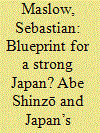

|
|
|
|
|
| Summary/Abstract |
Abe Shinzō has pledged to “take Japan back” from its constraining postwar regime. Redesigned institutions for intelligence and security policy coordination and “proactive pacifism” have facilitated the exercise of collective self-defense and strengthened the US–Japan alliance. The evolving security system is accelerating the dilution of Japan’s pacifist norms.
|
|
|
|
|
|
|
|
|
|
|
|
|
|
|
|
| 2 |
ID:
173152


|
|
|
|
|
| Summary/Abstract |
The level of alliance cohesion is measured along the following dimensions of alliance operation: attitudinal, behavioural, and functional. However, it is insufficient to evaluate the level of cohesion only by examining how those indicators have changed over time. If it were sufficient to do so, it would presume the level of alliance cohesion would be bound to become similarly high in cases such as those of the US-Japan and US-Philippines alliances in which the commonly perceived threat is now widely and deeply entrenched. This article argues that the capabilities dimension be included in the list of indicators evaluating the level of cohesion. The US places greater emphasis on encouraging its allied partners to address specific capability gaps, foster trust, and improve jointness and interoperability with the US forces and thus contribute further to the evolution of division of alliance labour in which they take a larger role in both regional and global defense as well as cater for their own needs. The evolving division of labour that has been facilitated—and made possible—by a junior ally's enhanced capabilities has incentivized both the US and its ‘capable’ ally to work together to enhance alliance cohesion and credibility.
|
|
|
|
|
|
|
|
|
|
|
|
|
|
|
|
| 3 |
ID:
137183
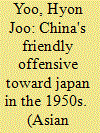

|
|
|
|
|
| Summary/Abstract |
This article explores why the People's Republic of China employed a surprisingly soft and lenient policy toward Japan in the 1950s despite their historical and political animosities. Relying on a relatively new concept in the study of international relations, I argue that China's conciliatory policy toward Japan represented a wedge strategy that was designed to detach Japan from the United States and weaken the US-Japan alliance. The logic of the theory also reveals that China's policy was in line with its “united front” against the United States during the Cold War.
|
|
|
|
|
|
|
|
|
|
|
|
|
|
|
|
| 4 |
ID:
186407


|
|
|
|
|
| Summary/Abstract |
Formal and informal modifications to the US-Japan Alliance have expanded the value the Alliance operational structure delivers in support of US and Japanese national and combined naval activities in Southeast Asia. This article analyzes how the Alliance now serves as an increasingly powerful force multiplier which magnifies the capabilities, efficiency, and impact of the two allies’ naval activities in Southeast Asia. Unlike previous studies on the role of the United States or Japan in the region, it focuses on the evolving functionality of the Alliance operational structure. The article systematically discusses how the evolving nature of the Alliance operational structure is enabling it to provide expanded support for Southeast Asian maritime security in five areas: basing, combined operations, partnerships and access, extra-regional coordination, and cooperative capacity-building. Those evaluations enable discussions of prospects for US and Japanese initiatives in Southeast Asia.
|
|
|
|
|
|
|
|
|
|
|
|
|
|
|
|
| 5 |
ID:
072430
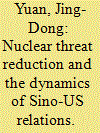

|
|
|
| 6 |
ID:
131880
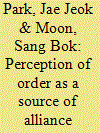

|
|
|
|
|
| Publication |
2014.
|
| Summary/Abstract |
The level of alliance cohesion is affected by the shift of attitudinal aspects (such as homogeneity in goals and threat perceptions) and behavioural aspects (such as strategic compatibility, command structure and defence burden-sharing) of alliance operation. In particular, a clear threat perception tends to make an alliance cohesive, as it suppresses (potential) disputes over the behavioural aspects of alliance operation. This article argues, however, that it is not sufficient to evaluate whether an alliance is cohesive or not only by looking at how these attitudinal and behavioural indicators have changed over time. If it were sufficient to do so, it would be supposed that the level of alliance cohesion would be bound to become lower with a change of government from conservative political forces to liberal ones in cases such as those of the US-ROK and the US-Japan alliances. We argue that the list of indicators for alliance cohesion should include not only attitudinal and behavioural aspects of alliance operation, but also functional aspects. While serving its primary purpose of responding to a specific threat, an alliance incurs an additional function of serving to maintain or to build a favourable regional order that is appreciated by both liberal and conservative governments. The interests in relation to order-building and order-maintenance motivate allies to invest for the alliance, often at their own political risk, even while they are engaged in contentious negotiations with the United States over attitudinal and behavioural aspects of alliance operations. Such investments can be considered as a different type of alliance burden sharing than has heretofore been given adequate attention. The investments indeed consolidate the alliance, paving the way for further upgrading of the alliance as conditions warrant.
|
|
|
|
|
|
|
|
|
|
|
|
|
|
|
|
| 7 |
ID:
127059
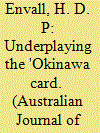

|
|
|
|
|
| Publication |
2013.
|
| Summary/Abstract |
The US military bases in the Japanese prefecture of Okinawa have long been a source of domestic political opposition to the US-Japan alliance. As an alliance management issue, the ongoing troubles surrounding the bases raise questions as to when and why states adopt particular bargaining strategies when dealing with allies. Why, for instance, has the Japanese government not made greater use of this 'Okinawa card' when negotiating alliance issues with the USA? Even though highlighting particular domestic problems as a part of a negotiating strategy (known as tying hands) should appeal to a weaker ally such as Japan, this article argues that in the Okinawan case the reverse has been true. Japan has generally, though not always, sought to minimise or downplay domestic opposition to its alliance agreements, essentially preferring a cutting-slack to a tying-hands approach. The Japanese experience suggests that when states which are directly dependent on an alliance for their security see their security environment as unstable, they view tying-hands strategies as too likely to undermine their bargaining credibility. Maintaining credibility is important in an alliance bargaining context because it is a way for such states to signal their commitment to an alliance and so guard against abandonment.
|
|
|
|
|
|
|
|
|
|
|
|
|
|
|
|
| 8 |
ID:
052187


|
|
|